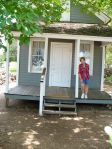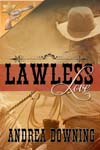I have as my guest today Karen Casey Fitzjerrell.  A Texas girl through and through, Karen was born near Houston in Baytown, near the tip of the Houston Ship Channel, and now lives in San Antonio. Formerly a freelance writer for several newspapers and regional magazines in the state, she recently turned to getting her fiction works out from under the bed and into the public eye for us all to enjoy. As a fellow member of Women Writing the West, she very kindly answered my plea for help on all things Texan, serving as background consultant to my own WIP. I’m indebted to her not only for that, but for feeding my fascination with the Sunday Houses I spotted in Hill Country. Over to Karen:
A Texas girl through and through, Karen was born near Houston in Baytown, near the tip of the Houston Ship Channel, and now lives in San Antonio. Formerly a freelance writer for several newspapers and regional magazines in the state, she recently turned to getting her fiction works out from under the bed and into the public eye for us all to enjoy. As a fellow member of Women Writing the West, she very kindly answered my plea for help on all things Texan, serving as background consultant to my own WIP. I’m indebted to her not only for that, but for feeding my fascination with the Sunday Houses I spotted in Hill Country. Over to Karen:
In The Dividing Season, my book set in 1910 West Texas, a woman rancher makes a surprising discovery in a Sunday House
that had been built by her grandfather in the late 1800s. The woman recalls many stories exchanged and rehashed between her father and his brother about the wild times they’d enjoyed in the Sunday House when they were young men. Stories of cheating poker games, plots to catch cattle rustlers and cattle buying contracts gone bad.
Until the book’s editor suggested that I explain what a Sunday House was, I hadn’t realized that few people are aware of the houses’ significance to German settlers who ranched and farmed the remote hills and prairies of Texas.
Think about it. Back in those early settlement days there were no Holiday Inns, Marriotts, or LaQuintas on every corner of town. When ranchers and farmers had business to conduct in town he—and as often as not she—rarely had time to finish his or her list of errands before having to head back home before full darkness. It became a common thing for settlers to build very small “houses,”
usually one room, ten feet by ten feet to twelve feet by fourteen feet, on small town lots for the convenience of having a place to stay overnight. Most of the houses had lofts tucked up under cedar or cypress roofs where children slept on cots. The lower floor had a curtained off area where adults slept. A “kitchen corner” with a small table and wash basin were about as elaborate as the tiny houses got.
Whole families would ride a wagon or buggy into town on Saturday mornings (a half day’s ride for most) and visit the dry goods store, hardware store, and bank. Then they’d stay overnight in their Sunday House and attend church services the next morning. Most carried along picnic baskets, and after church services they ate, napped, attended baseball games or visited relatives before the return trip home.
Time spent in town to buy supplies, attend church services and visit was often the only social activity families enjoyed after long weeks of isolation on remote ranches. In New Braunfels, Castorville and Fredericksburg, Sunday Houses were being built as late as 1909. When I researched Sunday Houses online for this blog post I’d hoped to find new insight as to why Sunday Houses seem particular to Texas. I’ve not run across any mention of them elsewhere in the U.S. with the exception of similar “houses” in 1660s Middlebury, Connecticut and in the Pennsylvania Dutch Country. I can only assume that the vast open, empty reaches of Texas necessitated the need for such a convenience.
The custom of Sunday Houses slowly died out with the introduction of motorized vehicles and better roads. Many of the houses still stand to this day and have been renovated as museums, tidbit tributes to a time gone by. Some have been modernized and are rented as Bed and Breakfast getaways.
While researching Sunday Houses for The Dividing Season I thought of the irony that today I reverse the pioneers’ Sunday House habit. I’m a city bound soul who always looks forward to a day trip down dusty roads leading into the heart of Texas. This is especially true in spring when wildflowers turn the roadways into brilliant paths of color. The trouble is – I’ve no Sunday House “out there” and so must return to the choke of city life before my hunger for empty stretches of land and sky is sated. I wonder what The Dividing Season’s cattlewoman would have said about my predicament.
turn the roadways into brilliant paths of color. The trouble is – I’ve no Sunday House “out there” and so must return to the choke of city life before my hunger for empty stretches of land and sky is sated. I wonder what The Dividing Season’s cattlewoman would have said about my predicament.
***********************************************************************
Thanks so much for visiting, Karen!
To find out more about The Dividing Season visit Karen’s website at: http://www.karencasyfitzjerrell.com
I’ve reviewed The Dividing Season on both Amazon and Goodreads, and here’s a bit of what I said:
“:…Fitzjerrell’s style is restrained yet poetic, capturing the atmosphere of the scenes she describes as well as their physical presence. Her characters come to life with those small, intimate details only a practiced eye detects, the minutiae and small gestures that embody the individual. Her keen observation breathes life into the everyday rituals of a time long gone and makes the reader yearn for a past he never knew. Such involvement with the book is well rewarded, although that is not to say that the story is predictable. While Fitzjerrell keeps a tight rein on her prose, the pages are kept turning until the very end.”


















HI Karen and Andrea,
The Dividing Season sounds like a very good read and I look forward to it. A visit to Fredericksburg several years ago brought me to a charming series of Sunday Houses and their lore. I suspect it would be hard to write of Germans during the era without references to these charmers. Good going, Karen. Thanks Andrea for hosting her.
LikeLike
Thanks Arletta. I’m glad to have Karen writing about this very interesting aspect of Texan history!
LikeLike
Yes, thanks for your interest, Arletta. I’m traveling and so my responses are not timely. However, I’m glad to know that someone “out there” knows of the charming little bits of Central Texas history.
KarenCaseyFitzjerrell
LikeLike
What a wonderful factoid about Sunday Houses! I well remember the scene in The Dividing Season where Nell utilizes her House when she goes to town. And now I know “the rest of the story!”
Thanks, Karen, for your great descriptive explanation of these tiny houses that, from your photos, exude an adult-sized dollhouse likeness 🙂 And thank you, Andi, for having Karen on your blog. I enjoyed the read.
Alice
LikeLike
You know, Alice, it seems the tiniest bits of history can provide huge opportunities when writing fiction!
Thanks for you comments!
KarenCaseyFitzjerrell
LikeLike
Utterly fascinating subject, those Sunday Houses! I look forward to reading Karen’s book. Thanks, Andrea.
LikeLike
Yes, it is fascinating. Andrea raised the question to me about some Sunday Houses having outside stairways up to the “lofts.” However, I’ve been lead to believe – by not easily confirmed research – that most were added after the era that I wrote about.
Thanks for your interest Irene!
KarenCaseyFitzjerrell
LikeLike
Fascinating is a good word for this. I remember my aunts home here in the Ozarks being packed with pallets on the floor when many of us would visit. She could’ve used a Sunday House more than once. Leave it to Texas, one of my favorite states.
LikeLike
Exactly Velda – leave it to the Texans. However, must remember that this “habit” began with the German settlers/ranchers. My mother’s side of our family hailed from Louisiana and pallets on the porch for company was the accepted courtesy for overnight visits.
Thanks for the comments.
KarenCaseyFitzjerrell
LikeLike
Karen, before reading your book, I’d never heard of a Sunday House. It’s a great concept for families back in those days. Might even be a good idea for families today!
LikeLike
Not a bad idea Helen….get those kids outta our hair!!! Surprised, Texas gal that you are, that you hadn’t heard of them.
Karen Casey Fitzjerrell
LikeLike
What an interesting piece, Andrea and Karen. A Sunday house! How interesting. I can certainly appreciate the need. Let’s have a party–your Sunday house or mine?
LikeLike
Hey – did you say Party? I don’t have a Sunday House but I do have a nice porch! Thanks for the offer Mary!
LikeLike
Karen–well, here’s one life-long Texas girl who knows what a Sunday House is. The German influence is so strong in Central Texas and the Hill Country. I live in San Marcos–our daughter and her family live in SA–so hi, neighbor! I enjoyed the post very much, and loved the photos. Congratulations on your book!
LikeLike
I lived in San Marcos for about five years, a tiny house not much bigger than the Sundays Houses. It was a “cottage” on Mitchell Street between Hunter and San Antonio street in the historical district. I loved that little house. In fact finished writing The Dividing Season there!
Thanks for sharing. Karen
LikeLike
Karen, thanks for sharing “the rest of the story.” I had never heard of Sunday Houses.
LikeLike
This certainly is a fascinating bit of history and it makes sense that country folk would need a place to stay when they went to town. I’m glad you shared this with us, Karen. The Dividing Season is a good book–I highly recommend it!
LikeLike
Thanks for the note and recommendation Heidi. I had a blast researching for Dividing Season.
karen
LikeLike
Thanks for a very interesting guest blog post, Karen!
LikeLike
I live in San Antonio, and I spent a lot of time in Fredericksburg, researching for my own series of novels about the German settlers there. There are still a great many of the Sunday Houses about; there is a lovely example on the grounds of the Pioneer Museum. The one thing that the German settlers were – was they were very social, and coming to town regularly was absolutely neccessary, None of that spending months and monts on a homestead for them. And they were also … frugal. When New Braunfels and Fredericksburg were being set up by the Mainzer Adelsverein, the first settlers were allocated a half-acre town lot, and a ten-acre farm lot. So, just about all the early settlers owned a little slice of land within town limits, and then a larger plot outside of it. It had been expected at first that the setters would do as they did in Germany; have their house in the village, and go out to the fields every day. It didn’t work that way for long – as ten acres was too small to make a living from, in the Hill Country, but that was the mind-set.
Many of the Sunday Houses and the larger homes had exterior staircases, because that was how houses had been built in Germany: it saved room, within the walls.
I created a ‘Sunday’ house for the family that I wrote about in the Adelsverein Trilogy – based on a real house; the Dangers house, on Creek Street. Several significant events took place there!
LikeLike
Thanks so much for expanding on Karen’s personal ‘take’ on the Sunday houses. I’m sure she’ll have something to add when she gets back from her current travels.
LikeLike
Andrea – thank you so much for inviting me to be your guest here.
Karen Casey Fitzjerrell
LikeLike
You’re very welcome, Karen. Thanks so much for telling us all about this interesting subject–and good luck with the book!
LikeLike
Celia, thank you! German pioneer history in this part of the state has so many wonderful tidbits for writing. The Sunday House at the start of my guest blog was taken at the Pioneer Museum in Fredericksburg. It’s the Weber House circa 1909. Maybe we’ll cross paths one day.
Karen
LikeLike
You are so welcome, Karen! Cross paths? It looks like we both started in our visualization of a Sunday house with the pretty little house at the Pioneer Museum! (I took a lot of my visualizations of the German pioneer’s “stuff” from exhibits there. When I did a history talk for the museum volunteers two years ago, they pulled some of the items from the exhibits – just for that! I tookl pictures of them – they’re on my website.)
Next Saturday, I’ll be at the 200th Birthday celebration for John Meusebach, up in Fredericksburg: he was the nobleman who took over and had a fair go at sorting out the fortunes of the Adelsverein.
Kenn Knopp is the local historian who has a Facebook page about it all –
http://www.facebook.com/events/405131616198681/405132389531937/
Maybe I’ll see you there, eh?
LikeLike
Sounds like a great time to be in Fredericksburg. Unfortunately I have obligations that’ll keep me in SA.
karen
LikeLike
I too had never heard of the Sunday Houses. Great idea. I have a German son-in-law whose ancestors were Volga Germans and settled in Kansas. I’ll have to e-mail him this post. Thanks Karen and Andi. Going now to Amazon and taking a look at Dividing Season.
LikeLike
Eunice – I just that minute uploaded a “corrected” version of Dividing Season to Kindle…..found some niggling errors that I felt needed to be dealt with. Might want to give it a few hours. Thanks for commenting and I’d love to hear what you think after reviewing the book on Amazon.
kcfitzjerrell
LikeLike